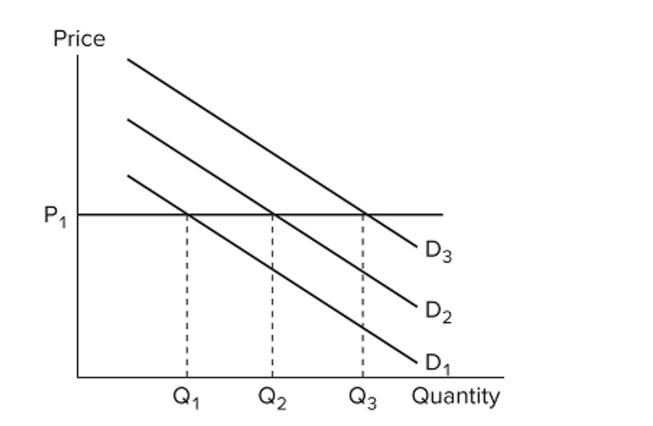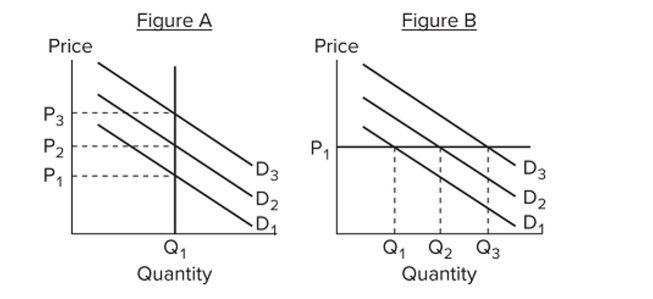B) False
Correct Answer

verified
Correct Answer
verified
True/False
In 2017, China's GDP per person was almost as high as that of the United States.
B) False
Correct Answer

verified
Correct Answer
verified
Multiple Choice
Financial institutions reward savers with the following, except
A) interest.
B) wages.
C) dividends.
D) capital gains.
F) All of the above
Correct Answer

verified
Correct Answer
verified
True/False
Business cycles refer to short-term fluctuations in prices.
B) False
Correct Answer

verified
Correct Answer
verified
True/False
Real GDP measures the change in the price level over time.
B) False
Correct Answer

verified
Correct Answer
verified
True/False
Buying 100 shares of Google stock would be an example of economic investment.
B) False
Correct Answer

verified
Correct Answer
verified
Multiple Choice
The two topics of primary concern in macroeconomics are
A) short-run fluctuations in output and employment and long-run economic growth.
B) unemployment and wage rates in labor markets.
C) monopoly power of corporations and small business profitability.
D) oil prices and housing markets.
F) A) and C)
Correct Answer

verified
Correct Answer
verified
True/False
Economists use the word investment to refer to the purchase of assets such as stocks, bonds, and real estate.
B) False
Correct Answer

verified
Correct Answer
verified
Multiple Choice
The major statistics that provide macroeconomists a picture of the health of an economy include the following, except
A) real gross domestic product.
B) inflation statistics.
C) prices of oil and gasoline.
D) unemployment data.
F) All of the above
Correct Answer

verified
Correct Answer
verified
Multiple Choice
Which of the following is not an important question that macroeconomic models help clarify?
A) Can governments reduce the severity of their economies' recessions?
B) Is a policy of manipulating interest rates more effective at mitigating short-run economic fluctuations than a policy of changing the tax rates?
C) How will OPEC manipulate and maintain the price of crude oil in the world markets?
D) Is there a trade-off between lower unemployment and lower inflation?
F) None of the above
Correct Answer

verified
Correct Answer
verified
Multiple Choice
Demand shocks
A) refer to unexpected changes in the desires of households and businesses to buy goods and services.
B) refer to unexpected changes in the ability of firms to produce and sell goods and services.
C) always have a negative effect on the economy.
D) cause fewer short-run fluctuations than supply shocks.
F) A) and D)
Correct Answer

verified
Correct Answer
verified
Multiple Choice
Suppose that prices are sticky in the short-run. Which of the following best describes the economy's response to a negative demand shock?
A) Firms' inventories will increase, causing them to cut production. Ultimately, real GDP will decrease and unemployment will increase.
B) Firms' inventories will decrease, causing them to increase production. Ultimately, real GDP will increase and unemployment will decrease.
C) Firms' inventories will increase, causing them to cut production. Ultimately, real GDP will increase and unemployment will increase.
D) Firms' inventories will increase, causing them to cut production. Ultimately, real GDP will decrease and unemployment will decrease.
F) B) and C)
Correct Answer

verified
Correct Answer
verified
Multiple Choice
If the prices of all goods and services rose, but the quantity produced remained unchanged, what would happen to nominal and real GDP?
A) Nominal and real GDP would both rise.
B) Nominal and real GDP would both be unchanged.
C) Real GDP would rise, but nominal GDP would be unchanged.
D) Nominal GDP would rise, but real GDP would be unchanged.
F) All of the above
Correct Answer

verified
Correct Answer
verified
Multiple Choice
Harry's Pepperoni Pizza Parlor produced 10,000 large pepperoni pizzas last year that sold for $10 each. This year Harry's again produced 10,000 large pepperoni pizzas (identical to last year's pizzas) But sold them for $12 each. Based on this information, we can conclude that Harry's production of Large pepperoni pizzas this year
A) increased nominal GDP by $20,000 but left real GDP unchanged.
B) increased nominal GDP by $120,000 and increased real GDP by $100,000.
C) left nominal GDP unchanged but increased real GDP by $20,000.
D) increased nominal GDP by $120,000 but left real GDP unchanged.
F) B) and C)
Correct Answer

verified
Correct Answer
verified
Multiple Choice
Business cycle fluctuations typically arise because
A) the actual supply of goods and services ends up being more or less than what consumers were expecting.
B) the actual demand for goods and services ends up being more or less than the expected supply of goods and services.
C) the actual demand for goods and services ends up being more or less than what firms were expecting.
D) prices tend to be flexible in the short run.
F) A) and C)
Correct Answer

verified
Correct Answer
verified
Multiple Choice
 Refer to the figure. Assuming this market is representative of the economy as a whole, a negative demand shock will most likely
Refer to the figure. Assuming this market is representative of the economy as a whole, a negative demand shock will most likely
A) cause inflation.
B) increase unemployment.
C) lower prices but leave output unaffected.
D) reduce both prices and output.
F) A) and C)
Correct Answer

verified
Correct Answer
verified
Multiple Choice
 Refer to the figures. Which figure(s) represent(s) a situation where prices are sticky?
Refer to the figures. Which figure(s) represent(s) a situation where prices are sticky?
A) A only
B) B only
C) both A and B
D) neither A nor B
F) C) and D)
Correct Answer

verified
Correct Answer
verified
Multiple Choice
(Consider This) Which of the following is an example of economic investment?
A) Volvo buys an old factory building from General Motors.
B) Nike buys a new machine that increases shoe production.
C) Bill Gates buys shares of stock in IBM.
D) Warren Buffet buys U.S. savings bonds.
F) A) and C)
Correct Answer

verified
Correct Answer
verified
Multiple Choice
Inventories rise when
A) actual demand for output is more than expected.
B) actual demand for output is less than expected.
C) actual supply of output is less than expected.
D) actual demand for output is about the same as expected.
F) B) and D)
Correct Answer

verified
Correct Answer
verified
Multiple Choice
Firms that choose to use a fixed-price policy
A) will tend to experience larger inventory changes than firms that follow a flexible-price policy.
B) will tend to experience smaller inventory changes than firms that follow a flexible-price policy.
C) find that their inventories do not respond to demand shocks.
D) will not hold inventories.
F) A) and D)
Correct Answer

verified
Correct Answer
verified
Showing 121 - 140 of 243
Related Exams